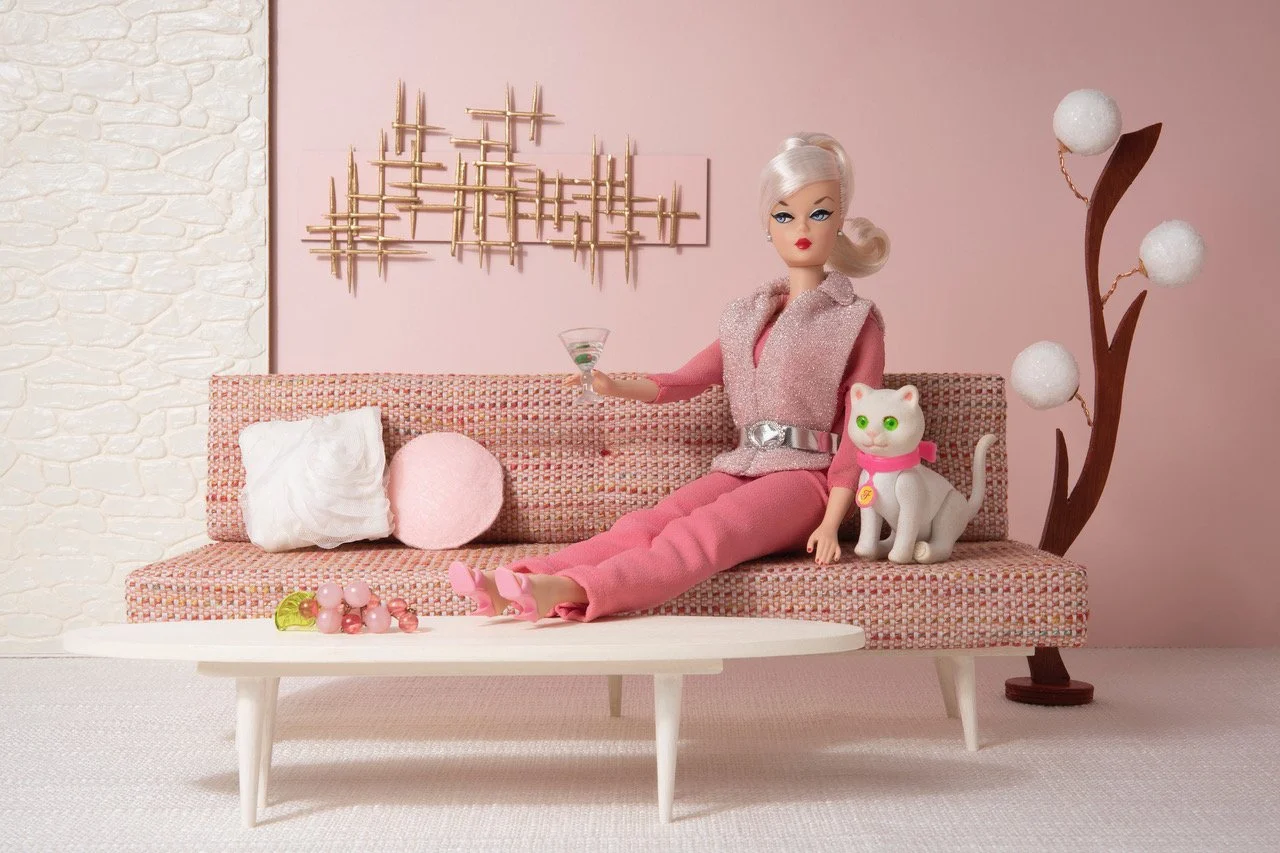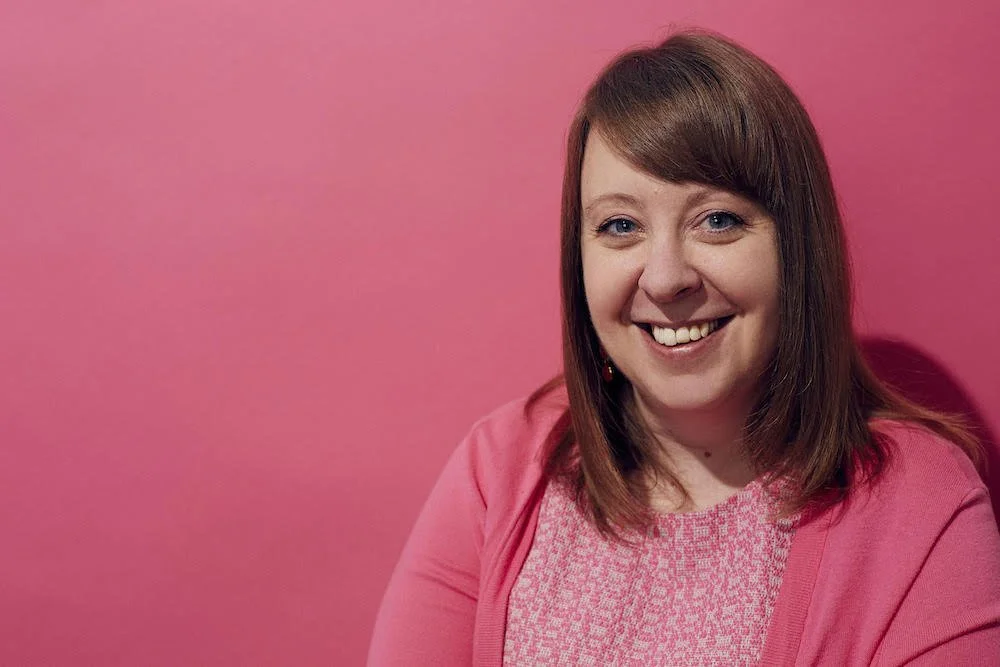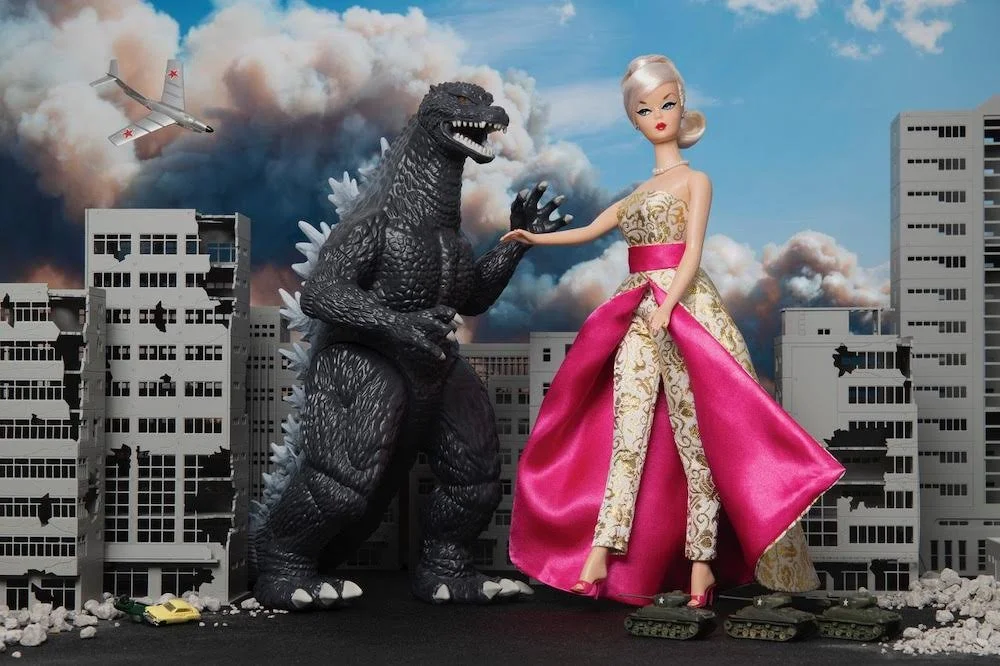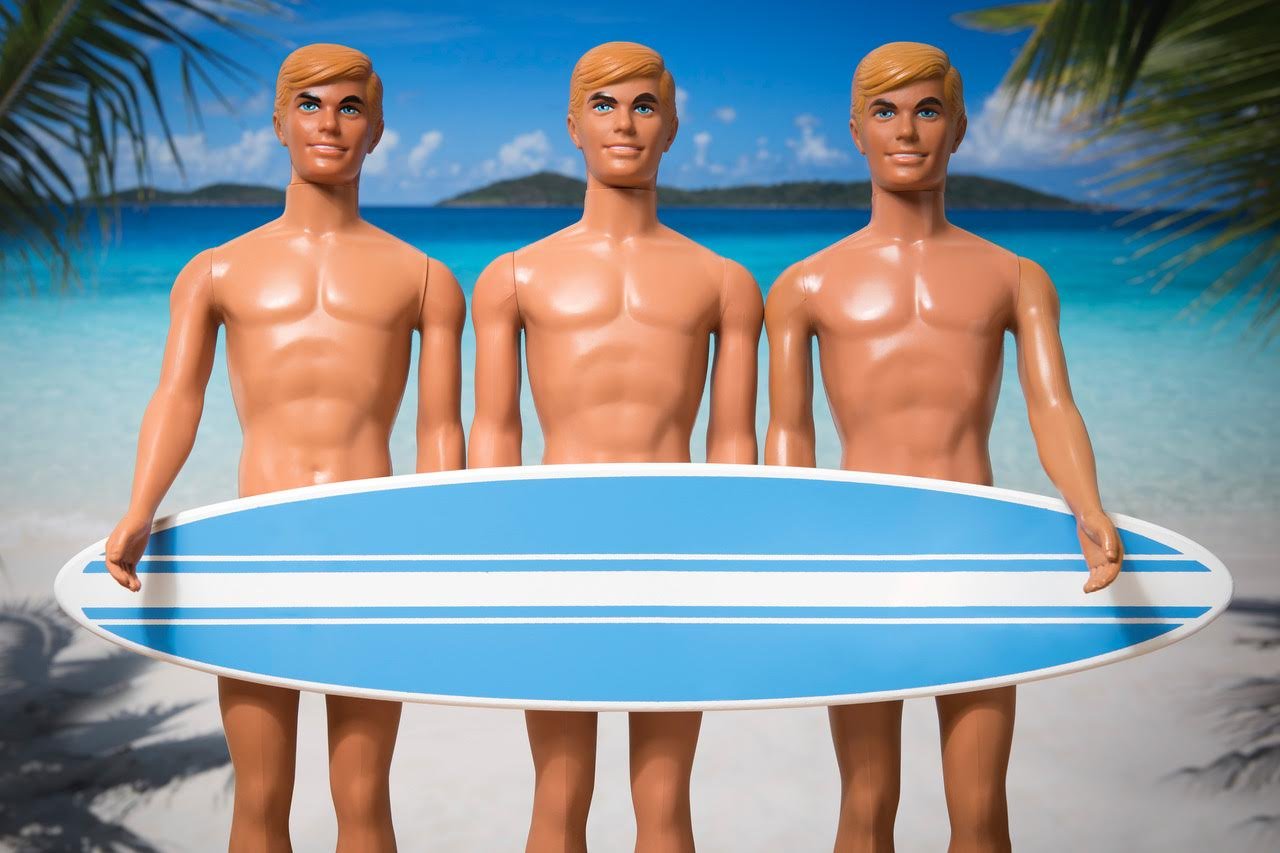Q&A with Nicole Houff: It's a Barbie World
Sip and Purr Barbie by Nicole Houff
2023 might have become the year of Barbie, but Minneapolis photographer Nicole Houff has been living in her own fantastic Barbie world for sixteen years and counting. After I fell in love with her gorgeous photo Barbie vs. Godzilla at the Minnesota State Fair Fine Art Exhibition last month (my mom had work in the show, too!), I soon realized that I used to have two of Nicole’s Barbie prints on my college dorm walls, which feels like forever ago. I wondered, was it really possible that one could make a long-lasting career out of making photographs of Barbie dolls? As it turns out, yes! Is it as fun as it sounds? As we discuss in our interview below, also yes.
Nicole Houff studied art at Macalester College before starting her career as a black-and-white photo printer. After the photo industry went digital, she worked at a commercial photo studio. After that industry changed too, Nicole took the leap to make art her career instead of her side gig—and the rest is Barbie art history. Nicole’s exquisite Barbie photography has been shown at Hopkins Center for the Arts, MPLS Photo Center, The Knockdown Center, Gamut Gallery, Intermedia Arts, Nash Gallery, Robbin Gallery, Praxis Gallery, and more. It was delightful and inspiring to talk with her about her process, her career trajectory, and how it’s more possible than you might think to follow your dreams.
Photo of Nicole Houff by Anna Rajdl
Q&A with Nicole Houff, photographer
Q: What led you to focus on Barbie in your photography?
A: It’s the combination of four factors: the first most obvious factor is that I love Barbie. But I’m not a traditional collector, in that I wasn’t a collector as a kid or anything. I actually started collecting after I got into my photographic series. But I of course love Barbie. And then, the most important thing: I always wanted to be an artist. Even as a kid, that was always a dream of mine. The third thing is that I have this affinity toward the 1950s and 60s visual aesthetic—design, art, pop culture, movies, TV, all that—which of course Barbie ties in really nicely with because she came out in 1959. The last piece—which really was the catalyst to get it all sort of gelled together—was the fact that I went back to school and studied commercial photography, which meant digital imaging, lighting, and more of the technical aspect of photography. Prior to that I had studied art in college, but studying commercial photography gave everything a clear direction. That’s what really got my current Barbie series going.
Q: What draws you to mid-century style?
A: With the really technical studio work, the mid-century modern color palette, fashion, clean design and lines have all just been really appealing. It ties in perfectly with this peak beginning of Barbie in the 1960s with its very focused fashion and aesthetic of the era.
Ski Lodge Barbie by Nicole Houff
Q: Does historical research ever play a role when you’re setting up photos?
A: The brainstorming is more when I’m looking for reference imagery. That’s often to kickstart an idea or a shoot. Like, right now I’m coming to the tail end of art fair season where I’m working every weekend, so I can go more into this heavy concepting phase, where I’m getting all the shoots ready so that—especially in the winter when I have way more time to spend in the studio—I’m ready to go. And you need to have a lot of the bits and pieces by that time, because otherwise it’s like, “I’m going to start a shoot,” but then, “Oh, well I actually need x, y, and z to even move forward, so now I have to wait another month for this to show up or to get this fabricated.”
During the phase when I’m really concepting is when I spend a lot of time online looking at old ads or old articles, or just Barbie stuff in general. I get a lot of newsletters from re-sellers and stuff, and sometimes that imagery, or mid-century modern architecture imagery, or even just shopping around and going to vintage shops—they all have that visual aesthetic. Getting out there and looking is important. I think any creative is the same way. You have to get amongst other things, not just what’s in your own studio or your own head, and that really kickstarts the concept.
Q: What is your creative process from idea to finished photo? And it sounds like you usually have multiple ideas going at a time?
A: Brainstorming is usually numerous images at once. Sometimes I will need components—like right now I’m looking for a particular outfit on eBay, so that process may take a while. So, while I’m working on that one, I’m like, “Okay, well, I can get a background ready for this other shoot.” So, when I’m doing the basic gathering of everything I’ll be working on a bunch at once. And then for the actual shoot, I usually focus on one at a time. Once it’s actually finished and it’s into the retouching stage, I may start shooting something else before the retouching is completed with one that I already photographed.
Godzilla vs. Barbie by Nicole Houff
So it starts with concept, and then I have to shop for everything. For some shoots, I already have everything in studio. But often there’s something I still need, so then it’s like, “Is this something I can get on eBay, can I get it on Etsy, is it something like a background picture that I need to go and photograph—what else is required?” Once that is movin’ and groovin’ and I feel like I have every single piece to do the shoot, then I get into the studio and I start roughing it in—lighting and camera angles and everything like that. The actual shoot itself may only take a day or a week. I would say the entire process takes about a month usually, some a little longer. Godzilla vs. Barbie was going on for months, because it was actually a different setup and then I didn’t like it and I needed to completely change the background, then I needed to change Barbie’s outfit, then I needed to change other elements to it.
The journey for each shoot is unique, but I would say on average each image takes around a month. That’s because after the photoshoot itself, you go into the retouching, which can be very extensive—sometimes twenty-some hours total of retouching. It’s amazing—even with the cleanest-looking doll—the amounts of wacky hairs or pits in the plastic! All those little things can take the viewer out of this weird reality that you’re presenting to them that’s almost, you know, human, like something we’d be doing, but on a plastic individual. After that I move into the test prints, so I can see what it looks like. That’s a good way to double-check color and my retouching. Sometimes when it’s printed you notice things that you didn’t see on the screen.
Q: The whole process sounds joyfully creative. Is there any part of it that feels most challenging?
A: The most exciting part is the concepting. The hardest part is when I’m fully committed to being in studio and it’s like, “Okay, now I have to make this look like what it does in my head.” The execution is the hardest, but it becomes the most exciting because as it starts coming together, there’s just nothing like it. It’s like you start from this anxiety of, “Oh my gosh, this isn’t going to work, what a waste of my time, what am I thinking?” to: it starts getting better. Maybe you have some pitfalls, but all of a sudden near the end of a shoot, it feels so good, and you feel like, “Now this is done, I’ve got it.” The best I always feel at a shoot is right then.
Longboard Kens by Nicole Houff
Q: Does retouching get laborious? As someone who doesn’t do any of this work, I’m always amazed at how intense retouching can get and the difference it makes.
A: Retouching is not my favorite, but it’s something where I always know there’s an answer. It’s not really the creative part, it’s the technical part. It doesn’t have that emotional impact that the actual shoot does. The thing with retouching is that it needs to look like it’s not retouched. Great retouching looks like the image just looked like that naturally. I’ve had a few where I’m like, “Holy smokes, the plastic on this doll is so bad!”—especially some of the Ken ones—and I’m like, “This is going to take forever; can I even do it?” And I can, you know. It takes a while. But there’s something really gratifying about that part of it too. It’s kind of the weird behind-the-scenes; most viewers don’t think about the retouching at all.
Q: I’m sure you’re tired of being asked this, but have you seen the Barbie movie?
A: I really enjoyed the Barbie movie. It hit on so many things—like nostalgia, there were the funny parts, there was the messaging part, and of course the visuals on it are just unbelievable. I mean, building those sets—that’s the thing where as an artist looking at it, you’re like, “Oh my gosh they built those sets, those aren’t CGI!”
Grain Belt Barbie by Nicole Houff
Last year when they started releasing teasers for the movie, I was at the Stone Arch Art Festival. Everybody was asking me about it. My booth neighbor looked at me and said, “Next summer is either going to be a nightmare for you or it’s going to be absolutely a dream.” And that’s how I went into this summer. The movie has created this insane Barbie buzz which is just unprecedented. I think the fun thing is, even if you’re not a hundred percent sold on the movie, it’s created this fun energy and I feel like everybody kind of feels that, so that fun energy and excitement has translated into my conversations with people this summer. And that’s been really beautiful. This strange little byproduct of the movie that I was not anticipating is this binding element with people of all ages and all genders.
I did have a few people who assumed when they saw me at an art fair this summer that I was trying to capitalize on the movie, which is a fair question because we see so much Barbie stuff being created now. But I’ve had enough opportunities to be like, “Oh, no, I’ve actually done this for sixteen years,” and talk about the process. Then they can see that it’s not like it’s stuff I can just whip together quick. I think that’s been expanding people’s art knowledge; the conversations have been much more in-depth this summer. Not just about Barbie but about the process, and that’s been incredibly cool.
Q: Do you think Margot Robbie’s Barbie will influence your own perception of Barbie or your artistic goals with her, or do you feel like you have a pretty solid independent relationship with Barbie?
A: I like in the movie how she points out that she’s “Stereotypical Barbie,” which really hits on how the dolls have evolved over time. The whole concept now is that their entire line of dolls, no matter size, color, anything—they’re all Barbie. How Margot Robbie did it was so perfect, because it does have the stereotypical things, but then she adds so much more depth to her character, and therefore to Barbie. Even if it’s not a direct influence, I don’t see how the movie couldn’t influence me or any other Barbie artist, because you’d always be thinking of it. So, I know that it will have an effect, I’m just not 100% sure what that looks like. Except I do want to do one with Allan in the pink power jumpsuit. Because I do have Allan dolls. I have him in some photos of mine but he’s sort of a background element. I might do a special shoot for Allan this fall just for fun, because that was such a perfect addition in that movie—Michael Cera as Allan.
Q: It's interesting that your early career pivots led to you doing what you’re doing now. Can you talk a bit about what that experience was like?
A: When I was done with my four-year college studying art, I got into the black-and-white photo industry—and that would be all film. It was a professional lab, so we were cranking out black-and-white prints for artists, wedding photographers, all that. I loved that job. I learned so much about photography and made friends that I still have. It really solidified my love for photography as my art form. It felt like that industry change was overnight but it definitely wasn’t—and of course there are still plenty of people who shoot film. I just happened to be at a lab that was obviously going to be phased out. And so, I was forced to look at a career that I thought I was going to do until I retired—that’s how much I liked that job—to be like, “What’s next? What can I do here?”
Road Trip Barbie by Nicole Houff
I ended up going back to school to study commercial photography. I knew nothing of digital at the time—I did not even have a digital camera, I was still using all film. So it forced me to learn something new, and on top of that, allowed me to stay within the industry. I was like, “This is fantastic!” All throughout this I was still doing art, but it was always what I did on the side. Even when I did film, I had done some Barbie stuff—the art doesn’t look like what the series looks like now, but I was experimenting with that.
So, I finished up school and I got a job at a commercial studio. I was on the production end. We would book models and hair, and it was so fun. We did these really cool commercial campaigns for, you know, photos that you see on billboards and in stores. It was an amazing experience and I learned more about the technical end. And again, I thought this was a career I was going to stick with. And then that industry started shifting to where places no longer have these big huge studios that they’re farming photoshoots out to. So, when I got let go from that, I threw in another job on top of that. I don’t know if I just didn’t have enough confidence in myself to know that I could take my art and make it my business, because I always thought that was the thing I did on the side. And even though I made some money off of it—because by this time I’d been doing some art fairs and I had set up an online shop—I just didn’t think that it could be my whole career.
I tried for a little bit to have a couple part-time jobs, but it became apparent that, you know, why not just move to doing art full-time? Why not put all my effort into it and see what happens? Because, to be perfectly honest, every year you don’t do it, is a year you’re, you know—don’t be scared! What’s the worst that’s going to happen? You have to go back and get a different job? Well, who cares? That’s nothing that scary, really. It seems scary, and I think it seems scarier when you’re younger. But in reality, the scariest thing is not trying. You get one shot, really. When I started thinking that way, and valuing myself and what I create, it was like, well why not? So I went all in.
Now I do more art fairs. I put more effort into selling online and doing advertising and expanding. And I couldn’t be more happy. Of course, all the previous experiences made me who I am so that I can do what I do now, and everybody’s journey’s different.
Astronaut Barbie by Nicole Houff
Q: What other advice do you have for artists who are trying to build a career in a world that’s constantly changing?
A: My biggest advice is that you don’t know it until you try it. Because again, the worst thing—and it's not even bad—is what if maybe you can’t sustain yourself right now as an artist? Then get a part-time job! But don’t give up. The biggest hurdle is trying, is starting. But that’s also exciting.
It’s so ingrained in people like, “Oh, the poor starving artist” or whatever—but there are so many of us out there where, that is our job! That’s what we do. And I would never in a million years change what I do. I love it. During one of my last interviews, they were asking me what Barbie means to me. And Barbie, to me, is the embodiment of the idea that you can do whatever you want. Barbie can be anything and anybody can be Barbie. And even though I don’t look in any way, shape or form like Barbie, I am a working artist. I literally live my dream every single day. That is what I’ve always wanted to do and that is what I do every day. If that’s not the epitome of Barbie, I don’t know what is.
Q: You’re Artist Barbie!
A: You know what I mean? Anybody can be. We can all be artists.
You can learn more about Nicole at her website, buy prints (treat yourself!) from her Etsy shop, and follow her on Instagram for all the mid-century Barbie goodness.
Check out this New York Times article to learn more about how they built those Barbieland sets in the Barbie movie. According to production designer Sarah Greenwood: “It was one of the most difficult philosophical, intellectual, cerebral pieces of work we’ve ever done.”
For Minnesotans and Minnesota visitors, save this list of local art fairs for next summer! (But for now, it’s time to start collecting your own bits and pieces so that you’re ready to execute your ideas during the upcoming winter creativity hibernation.)








